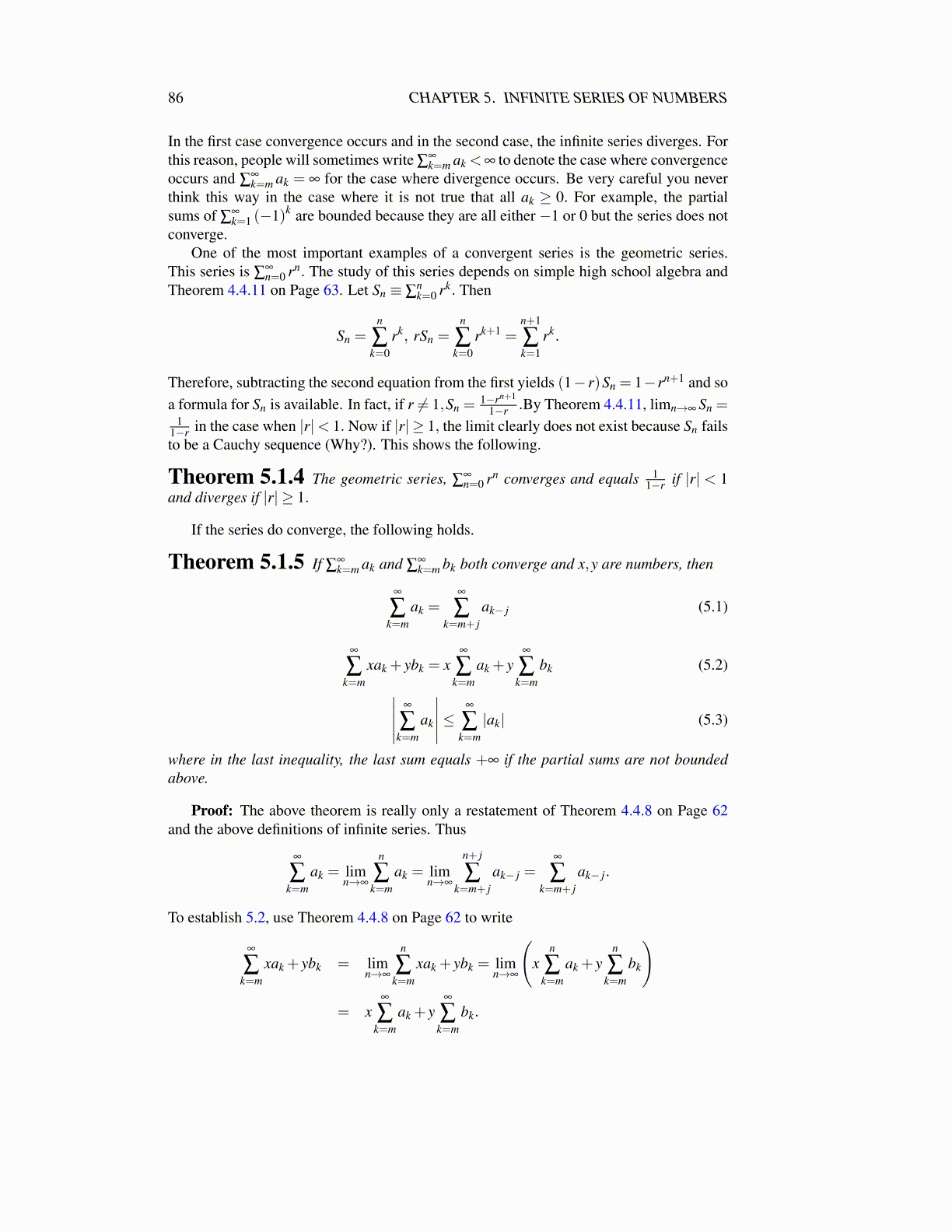
86 CHAPTER 5. INFINITE SERIES OF NUMBERS
Theorem 5.2.3 Let θ : N→ N be one to one and onto. Suppose ∑∞k=1 ak converges
absolutely. Then ∑∞k=1 aθ(k) = ∑
∞k=1 ak.
Proof: From absolute convergence, there exists M such that
∞
∑k=M+1
|ak| ≡
(∞
∑k=1|ak|−
M
∑k=1|ak|)
< ε.
Since θ is one to one and onto, there exists N ≥M such that
{1,2, · · · ,M} ⊆ {θ (1) ,θ (2) , · · · ,θ (N)} .
It follows that it is also the case that ∑∞k=N+1
∣∣aθ(k)∣∣ < ε. This is because the partial sums
of the above series are each dominated by a partial sum for ∑∞k=M+1 |ak| since every index
θ (k) equals some n for n ≥ M + 1. Then since ε is arbitrary, this shows that the partialsums of ∑aθ(k) are Cauchy. Hence, this series does converge and also∣∣∣∣∣ M
∑k=1
ak−N
∑k=1
aθ(k)
∣∣∣∣∣≤ ∞
∑k=M+1
|ak|< ε
Hence ∣∣∣∣∣ ∞
∑k=1
ak−∞
∑k=1
aθ(k)
∣∣∣∣∣≤∣∣∣∣∣ ∞
∑k=1
ak−M
∑k=1
ak
∣∣∣∣∣+∣∣∣∣∣ M
∑k=1
ak−N
∑k=1
aθ(k)
∣∣∣∣∣+
∣∣∣∣∣ N
∑k=1
aθ(k)−∞
∑k=1
aθ(k)
∣∣∣∣∣< ∞
∑k=M+1
|ak|+ ε +∞
∑k=N+1
∣∣aθ(k)∣∣< 3ε
Since ε is arbitrary, this shows the two series are equal as claimed.So what happens when series converge only conditionally?
Example 5.2.4 Consider the series ∑∞k=1 (−1)k 1
k . Show that there is a rearrangementwhich converges to 7 although this series does converge. (In fact, it converges to − ln2for those who remember calculus.)
First of all consider why it converges. Notice that if Sn denotes the nth partial sum, then
S2n−S2n−2 =1
2n− 1
2n−1< 0
S2n+1−S2n−1 = − 12n+1
+1
2n> 0
S2n−S2n−1 =1
2nThus the even partial sums are decreasing and the odd partial sums are increasing. Theeven partial sums are bounded below also. (Why?) Therefore, the limit of the even partialsums exists. However, it must be the same as the limit of the odd partial sums becauseof the last equality above. Thus limn→∞ Sn exists and so the series converges. Now I willshow later that ∑
∞k=1
12k and ∑
∞k=1
12k−1 both diverge. Include enough even terms for the
sum to exceed 7. Next add in enough odd terms so that the result will be less than 7. Nextadd enough even terms to exceed 7 and continue doing this. Since 1/k converges to 0, thisrearrangement of the series must converge to 7. Of course you could also have picked 5 or−8 just as well. In fact, given any number, there is a rearrangement of this series whichconverges to this number.